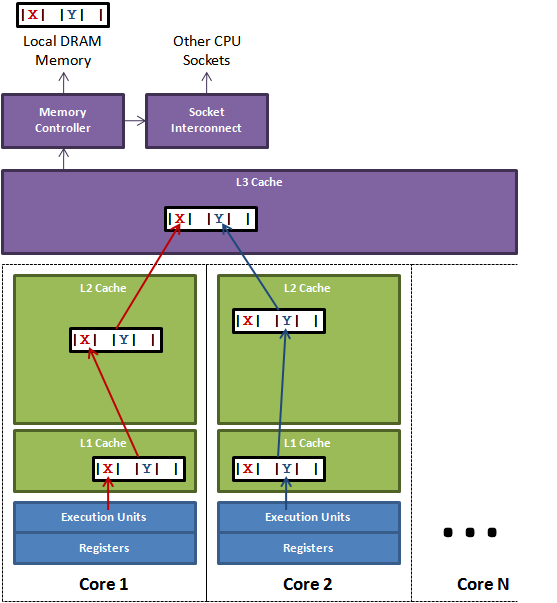在多核的CPU架构中,每一个核心core都会有自己的缓存行(cache line),因此如果一个变量如果同时存在不同的核心的cache line时,就会出现伪共享(false sharing)的问题。此时如果一个核心修改了该变量,该修改需要同步到其它核心的缓存。

上图说明了伪共享的问题。在核心1上运行的线程想更新变量X,同时核心2上的线程想要更新变量Y。不幸的是,这两个变量在同一个缓存行中。每个线程都要去竞争缓存行的所有权来更新变量。如果核心1获得了所有权,缓存子系统将会使核心2中对应的缓存行失效。当核心2获得了所有权然后执行更新操作,核心1就要使自己对应的缓存行失效。这会来来回回的经过L3缓存,大大影响了性能。如果互相竞争的核心位于不同的插槽,就要额外横跨插槽连接,问题可能更加严重。
我们可以通过padding来确保两个共享变量不位于同一个cache-line中,这对于链表等传统结构的共享(首尾节点通常位于同一cache-line)有重大意义。如下面这个例子:
1
2
3
4
5
6
7
8
9
10
11
12
13
14
15
16
17
18
19
20
21
22
23
24
25
26
27
28
29
30
31
32
33
34
35
36
37
38
39
40
41
42
43
44
45
46
47
48
49
50
51
52
53
54
55
56
57
58
59
60
61
62
63
|
#include<thread>
#include <iostream>
using namespace std;
struct foo {
int x;
/*
int64_t pad1;
int64_t pad2;
int64_t pad3;
int64_t pad4;
int64_t pad5;
int64_t pad6;
int64_t pad7;
int64_t pad8;
int64_t pad9;
int64_t pad10;
int64_t pad11;
int64_t pad12;
int64_t pad13;
int64_t pad14;
int64_t pad15;
int64_t pad16;
*/
int y;
};
static struct foo f;
void sum_a(void)
{
clock_t start = clock();
int s = 0;
int i;
for (i = 0; i < 1000000000; ++i)
s += f.x;
cout << "sum_a cost: "<< clock()-start << "ms"<< endl;
}
void inc_b(void)
{
clock_t start = clock();
int i;
for (i = 0; i < 1000000000; ++i)
++f.y;
cout << "inc_b cost: "<< clock()-start << "ms"<< endl;
}
int main()
{
std::thread t1(sum_a);
std::thread t2(inc_b);
t1.join();
t2.join();
return 0;
}
|
未添加padding时,在我的机器上运行结果为:
inc_b cost: 4692ms
sum_a cost: 5722ms
添加padding后,运行结果为:
inc_b cost: 2161ms
sum_a cost: 2194ms
